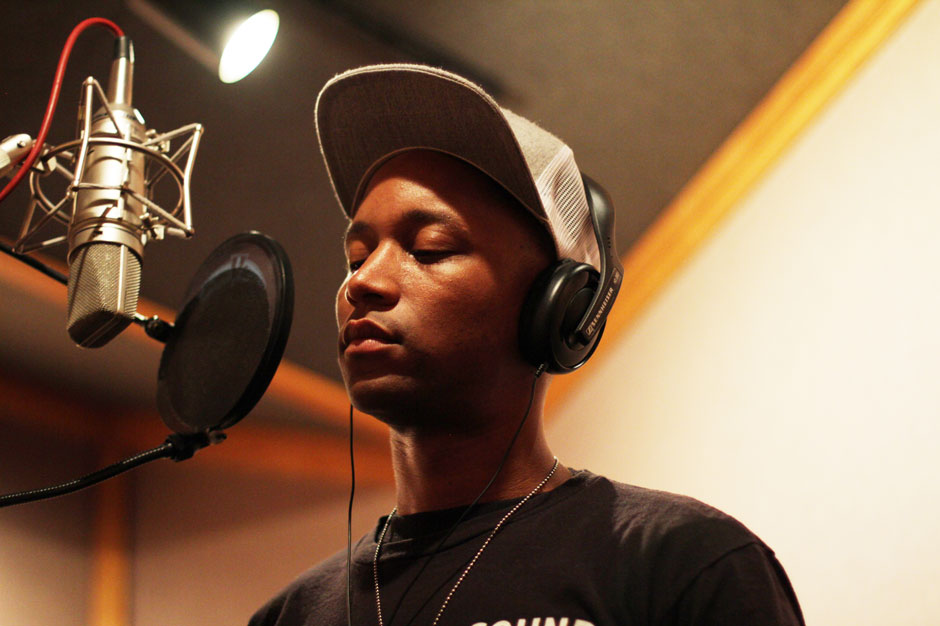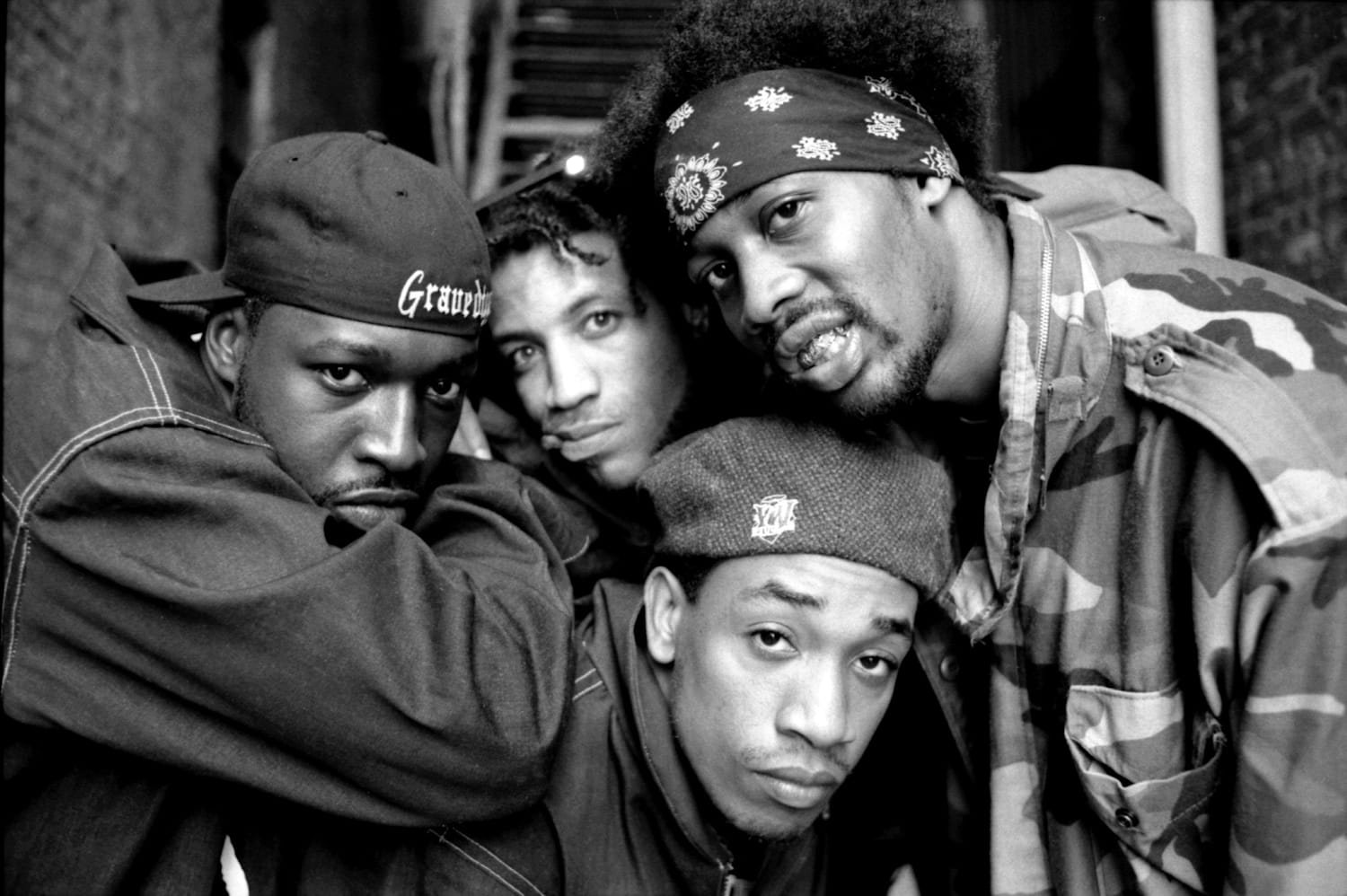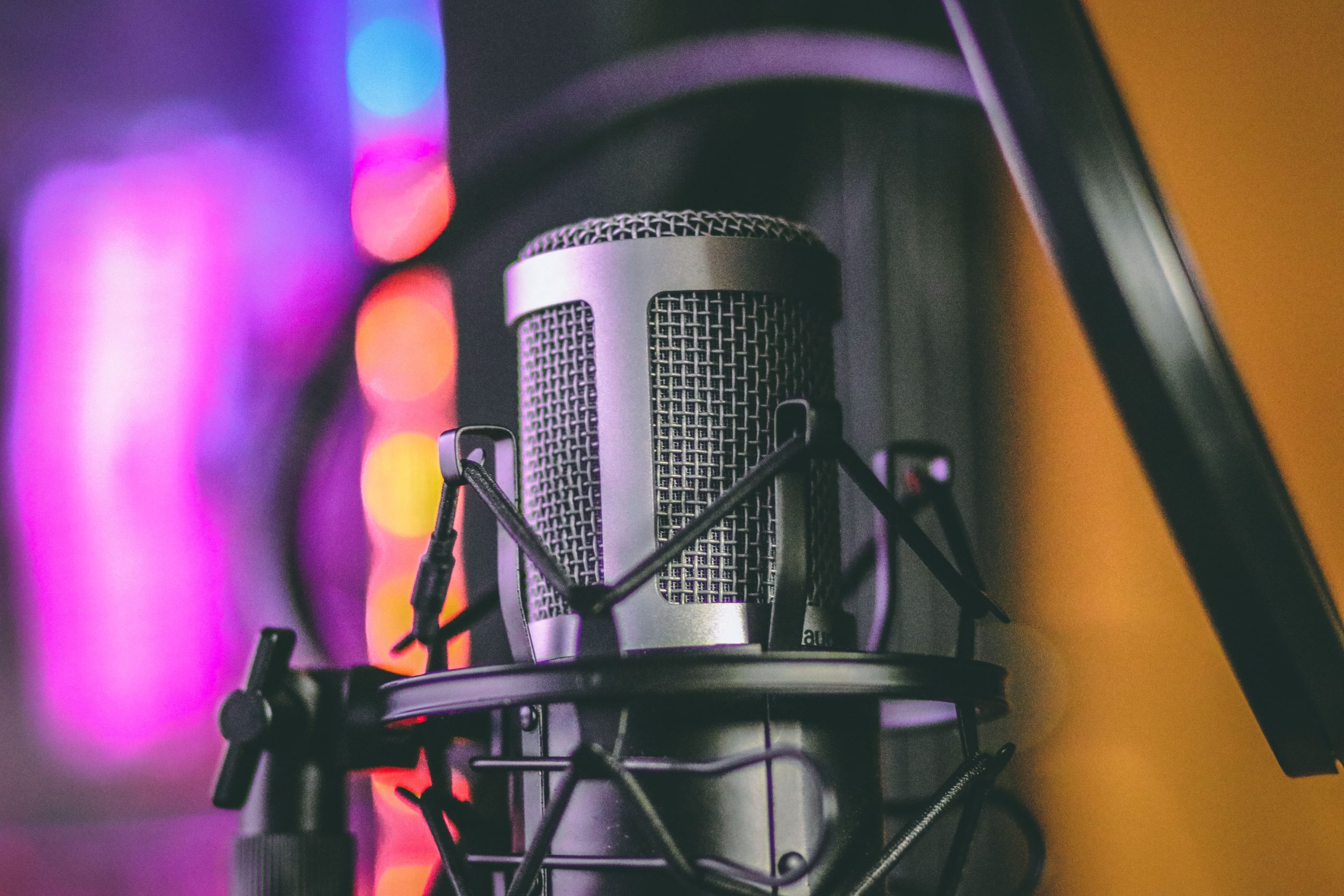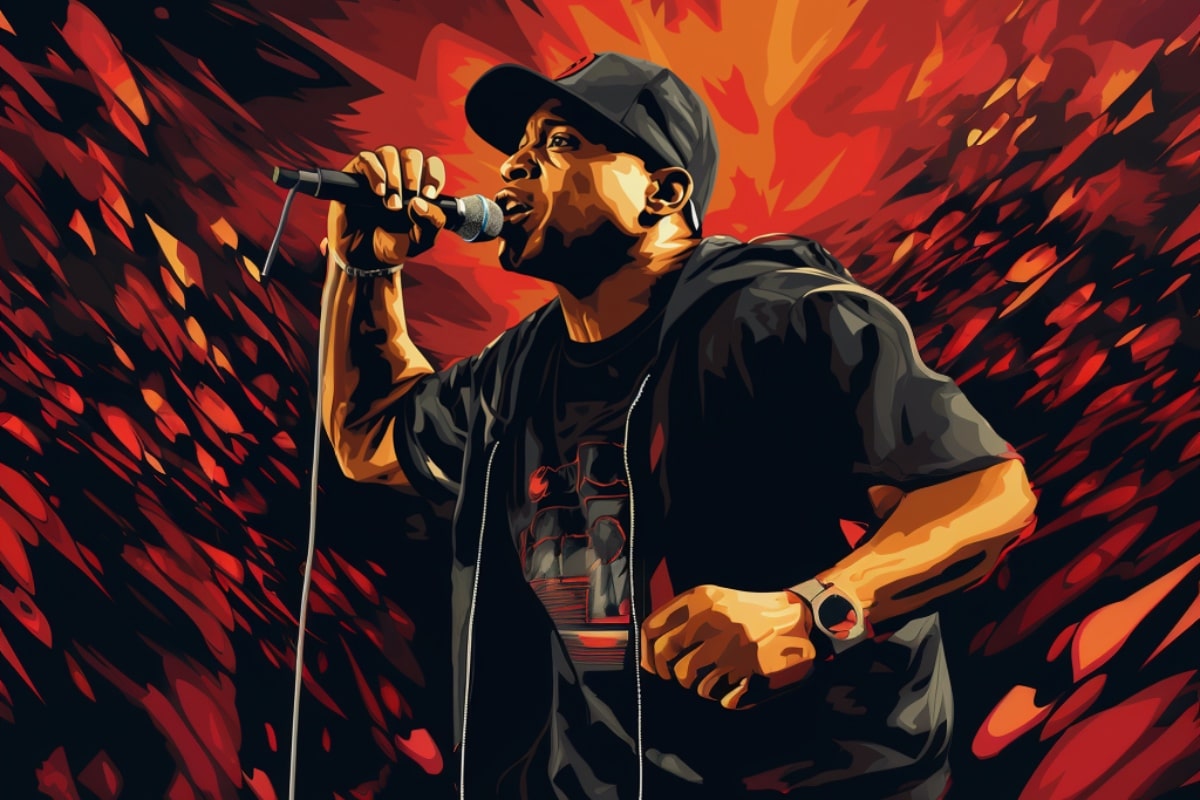It’s easier than you might imagine to record professional-quality rap at home – especially if you follow these ten tips.
1. Choosing and positioning microphones

As well as your computer, DAW, and EVO audio interface, there are only three other items you need to budget for when recording rap: a microphone, a stand to mount it on, and a pop screen. While sung vocals are often well suited to the more sensitive condenser microphone type, the aggressive delivery of rap is generally best suited to a dynamic mic. With its flattering response and exceptional durability, the Shure SM58 is always a safe bet. And as for the pop filter, any model will do – a tenner should easily cover it.
With the mic on its stand, pointing directly at the vocalist’s mouth, experiment with the distance between the two – the closer the vocalist is to the mic, the more the bass-boosting proximity effect will kick in, so do some test recordings and see what works best for your particular rapper. The pop filter, meanwhile, should be about 6″ in front of the mic.
One of the aims of any vocal recording is to capture it with as little room reverberation as possible. Although there are various ‘reflection filters’ on the market that can help with this in the home studio, they are only moderately effective, and you’ll get much better results by hanging a couple of quilts in a corner of the room or lining a wardrobe with soft furnishings of any kind to create an impromptu vocal booth.
2. Prepare to perform

When it comes to recording vocals, there are a few things you can do to make sure you get the best possible performance. One important step is to prepare in advance. This means doing things like warming up your voice, drinking plenty of water to stay hydrated, and practicing your vocal parts beforehand so you feel confident and ready when you step into the recording booth.
Another thing to think about is the environment you’ll be recording in. Make sure it’s quiet and free of distractions so you can concentrate on your performance. Finally, be sure to communicate with your engineer or producer about any special needs or preferences you have for your recording. With a little preparation, you’ll be ready to deliver a great vocal performance!
A great performance is obviously essential for any vocal track, but since rap tends to be more about drama and attitude than “vocals”, getting your MC firing on all cylinders should be considered mission-critical. There’s nothing like a well-massaged ego to bring out the best in a vocalist, so say everything you can to boost their confidence and enthusiasm without being unrealistic, and be positive and constructive with any criticism of the rap they’re about to serve up.
When judging the performance itself, look for pronunciation ‘mistakes’, and get your rapper to go through anything that’s imperfectly pronounced, vague or woolly until they get it perfect – every word should be clear and distinct. Also pay close attention to the lyrics, and if any of them seem even remotely clichéd, unconvincing or awkward, strongly suggest a rewrite of the offending section(s). The last thing you want is to undermine the authenticity of the track with a faltering delivery or poor penmanship.
Once all this is sorted and the rap is 100% ready to go, give the artist as many run-throughs as they need to prepare for the actual take – but sneakily record them while they do it, in case it turns out that they perform best without the pressure of the red light.
3. Compose and edit to perfection

When it comes to comping and editing rap vocals, there are a few things you can do to ensure a polished and professional sound. Firstly, make sure you select the best takes from your recording session and put them together into a cohesive performance. This process is called comping and involves selecting the strongest parts of each take and splicing them together to create a final performance that showcases your best work.
Once you’ve comped your vocals, it’s time to edit them. This involves adjusting the timing and pitch of each section to make sure everything lines up perfectly and sounds in tune. You can also add effects such as reverb, delay and compression to enhance the sound and give it more depth.
When editing rap vocals, it’s important to keep the rhythm and flow of the lyrics in mind. Make sure the timing of each word and phrase matches the beat and feels natural. You can also experiment with different vocal effects and processing techniques to create a unique sound that makes your vocals stand out.
Overall, comping and editing rap vocals takes time and attention to detail, but the results can be well worth the effort. With the right techniques and a little practice, you can create a polished and professional-sounding rap vocal performance that really stands out.
These days, just about every DAW has a comping system that allows multiple takes to be stacked in ‘lanes’ on a single track. They can then be spliced together effortlessly to create a perfect, continuous performance. Take advantage of this and get as many takes out of your singer as possible before fatigue and/or boredom sets in. If, on the other hand, you’re using a DAW that doesn’t yet support comping, you’ll need to record multiple takes on multiple tracks and then edit them all together on a ‘master’ track.
However, be as microscopic as necessary when composing and editing to get the best possible rap, right down to merging syllables from separate takes to optimize individual words and making the tiniest of timing changes. Time-stretching and pitch-shifting words and syllables isn’t necessarily a no-no, as long as you can do it completely transparently – very small changes that no listener would ever know had been made.
4. Enhance the track with doubles and ad-libs

If you want to elevate your rap vocals and make them stand out, adding doubles and ad-libs to your track can be a game-changer. Doubles are essentially multiple recordings of the same vocal part that are layered on top of each other, creating a fuller and more robust sound. Meanwhile, ad-libs are impromptu vocalizations, such as shouts or exclamations, that are added to the track to bring more energy and personality to the performance.
To create doubles, all you need to do is record additional vocal takes of the same part and layer them on top of the main performance. You can then adjust the pitch and timing of each double to create a more intricate and elaborate sound. As for ad-libs, they can be recorded separately and added to the track during the editing process. You can experiment with different ad-lib styles and rhythms to create a unique and unforgettable vocal performance.
By incorporating doubles and ad-libs into your rap vocals, you can create a more dynamic and captivating sound that captures your audience’s attention. However, remember to meticulously comp and edit your vocals before adding these elements to ensure that your final sound is polished and professional. With dedication and attention to detail, you can take your rap vocals to the next level and showcase your individual style and sound. As well as your computer, DAW, and EVO audio interface, there are only three other items you need to budget for when recording rap: a microphone, a stand to mount it on, and a pop screen. While sung vocals are often well suited to the more sensitive condenser microphone type, the aggressive delivery of rap is generally best suited to a dynamic mic. With its flattering response and exceptional durability, the Shure SM58 is always a safe bet. And as for the pop filter, any model will do – a tenner should easily cover it.
You’ll probably want to include double tracks and ad-libs in your rap vocals as well as the main part. The latter is largely a matter of getting your rapper to vibrate with the vocal he’s already laid down, and recording his spontaneous (or planned) improvisations on a separate track to be mixed in as required. However, there’s more to vocal doubles than that. They require accurate duplication – and even triplication or more – of the main vocal, which some rappers will be better at than others. Of course, your DAW will give you all the tools you need to tighten up vocal stacks manually, but if you work a lot with rap (or sung) vocals, SynchroArts’ VocAlign Ultra plugin is well worth a try for its quasi-magical ability to automatically align multitrack vocals in both time and pitch.
5. Compress and EQ to shape the sound

If you want to make your rap vocals sound amazing, you need to compress and EQ the audio. Compression helps to balance out the levels of your vocals, giving them a consistent and polished sound. EQ, on the other hand, lets you adjust the frequencies of your vocals, focusing on certain elements and reducing others. To get started with compression, use a moderate ratio and a fast attack time to catch the high points of your performance. Adjust the release time to match the rhythm of your track, and use makeup gain to compensate for any perceived loss in volume. Be careful not to over-compress, as this can make your vocals sound unnatural and flat.
When it comes to EQ, begin by cutting out any unwanted low frequencies below 100Hz to reduce any rumbling or muddiness. Boost the midrange frequencies around 2kHz to add clarity and presence to your vocals, and experiment with cutting or boosting the high frequencies around 8kHz to 10kHz to reduce any hissing or add airiness. Use a high-pass filter to remove any remaining unwanted low frequencies, and a low-pass filter to roll off any harsh high frequencies.
By using compression and EQ, you can shape the sound of your rap vocals to match your unique style and preferences. Just remember to listen carefully and make adjustments as needed to achieve that professional and polished sound you’re after.
A great rap vocalist should have a front and center dynamic consistency and the key to this is compression. Set your compressor’s ratio moderately high, tweak the attack and release times to control the punch and density of the sound, and try overdriving the input a little to introduce the slightest touch of distortion.
6. Selecting a microphone

A good quality microphone is essential for capturing the nuances of your voice. Look for a condenser microphone with a cardioid pickup pattern for the best results.
it’s important to consider your specific needs and requirements. Are you recording vocals or instruments? Will you be using the microphone in a noisy environment? Do you need a directional microphone to pick up sound from a specific direction? These are all factors to consider when choosing the appropriate microphone. Research different types of microphones, read reviews, and if possible, try them out before making a decision. Remember, the right microphone can make a huge difference in the quality of your recordings or sound amplification.
7. Find the right room

Record in a quiet room with minimal background noise and good acoustics. You can use sound-absorbing materials such as blankets or foam to improve the acoustics if necessary.
When choosing a room for recording rap vocals, it’s important to find a space that is quiet and has minimal background noise. This will help ensure the best possible sound quality for your recording. If you know the name of the building or location where you will be recording, I can look up the available rooms and their specifications to find the best one for your needs. Let me know any additional details you may have, and I’ll be happy to assist you in finding the perfect room for your recording session.
8. Use a pop filter

A pop filter helps reduce plosives and other unwanted noise caused by air hitting the microphone. It’s a small investment that can make a big difference to the quality of your recordings.
For recording rap vocals, using a pop filter can greatly improve the sound quality of your recordings. Not only can it reduce pops and other unwanted noises, but it can also help to ensure that your vocals are clear and crisp. Simply attach the pop filter to your microphone and position it between your mouth and the mic. This will help to filter out any unwanted sounds and keep your vocals sounding their best.
9. Warm up your voice

Before recording, warm up your voice to prevent strain and ensure the best possible performance. You can do simple vocal exercises like lip trilling or humming to get your voice ready.
In preparation for recording rap vocals, it is essential to undertake vocal warm-up exercises. This will enable you to produce high-quality sound while safeguarding your vocal cords against injury or strain. By warming up your voice, you’ll be able to achieve the desired tone and pitch while maintaining your vocal health and preventing any potential damage.
10. Take breaks

Recording can be physically and mentally exhausting. Take frequent breaks to rest your voice and your ears, and return to recording with renewed energy.
By following these tips and using compression and EQ techniques, you can create high-quality rap vocal recordings that showcase your talent and style.
To ensure top-notch rap vocals, it is crucial to prioritize the health of your voice. To prevent vocal strain and fatigue, it’s recommended to take regular breaks while recording. Setting a timer for every 30 minutes serves as a helpful reminder to rest your voice. During these breaks, it’s recommended to stretch your vocal cords, hydrate with water, and allow your voice to rest. By taking care of your voice, you’ll not only produce better-quality vocals but also prevent long-term damage to your voice.
Finally, don’t be afraid to experiment and have fun with the recording process. The more comfortable you feel, the better your performance will be.
Buy 2, Get 3 Beats – Unlimited Rights | Choose Your File Format
Unlock incredible value with our exclusive offer: Buy 2 beats, and receive 3 additional beats for free! Each license grants you unlimited rights, providing the freedom to use and distribute your music without limitations.
Select your preferred file format for the beats, tailored to suit your creative process and production needs. Whether it’s WAV, MP3, or other formats, we’ve got you covered.
Why Choose Us:
- Buy 2, Get 3 Free: Amplify your music collection without breaking the bank.
- Unlimited Rights: Enjoy complete freedom to use the beats in your projects.
- High-Quality Formats: Choose from various file formats for seamless integration.
Our beats cater to various genres and styles, ensuring versatility for artists, producers, and content creators. Elevate your sound and take advantage of this incredible offer today. Go To Beat Store